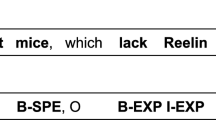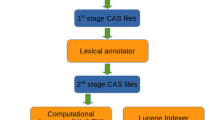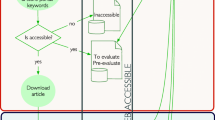Abstract
Knowledge discovery via an informatics resource is constrained by the completeness of the resource, both in terms of the amount of data it contains and in terms of the metadata that exists to describe the data. Increasing completeness in one of these categories risks reducing completeness in the other because manually curating metadata is time consuming and is restricted by familiarity with both the data and the metadata annotation scheme. The diverse interests of a research community may drive a resource to have hundreds of metadata tags with few examples for each making it challenging for humans or machine learning algorithms to learn how to assign metadata tags properly. We demonstrate with ModelDB, a computational neuroscience model discovery resource, that using manually-curated regular-expression based rules can overcome this challenge by parsing existing texts from data providers during user data entry to suggest metadata annotations and prompt them to suggest other related metadata annotations rather than leaving the task to a curator. In the ModelDB implementation, analyzing the abstract identified 6.4 metadata tags per abstract at 79% precision. Using the full-text produced higher recall with low precision (41%), and the title alone produced few (1.3) metadata annotations per entry; we thus recommend data providers use their abstract during upload. Grouping the possible metadata annotations into categories (e.g. cell type, biological topic) revealed that precision and recall for the different text sources varies by category. Given this proof-of-concept, other bioinformatics resources can likewise improve the quality of their metadata by adopting our approach of prompting data uploaders with relevant metadata at the minimal cost of formalizing rules for each potential metadata annotation.






Similar content being viewed by others
References
Ambert, K. H., & Cohen, A. M. (2012). Text-mining and neuroscience. International Review of Neurobiology, 103, 109–132.
Anderson, J. C., Binzegger, T., Kahana, O., Martin, K. A. C., & Segev, I. (1999). Dendritic asymmetry cannot account for directional responses of neurons in visual cortex. Nature Neuroscience, 2(9), 820–824.
Ascoli, G. A. (2015). Sharing neuron data: carrots, sticks, and digital records. PLoS Biology, 13(10), e1002275.
Beech, D. J., & Barnes, S. (1989). Characterization of a voltage-gated K+ channel that accelerates the rod response to dim light. Neuron, 3, 573–581.
Cohen, K. B., & Hunter, L. (2008). Getting started in text mining. PLoS Computational Biology, 4(1), e20.
Cornelisse, L. N., van Elburg, R. A. J., Meredith, R. M., Yuste, R., & Mansvelder, H. D. (2007). High speed two-photon imaging of calcium dynamics in dendritic spines: consequences for spine calcium kinetics and buffer capacity. PLoS One, 2(10), e1073.
Crasto, C. J., Marenco, L. N., Migliore, M., Mao, B., Nadkarni, P. M., Miller, P., & Shepherd, G. M. (2003). Text mining neuroscience journal articles to populate neuroscience databases. Neuroinformatics, 1(3), 215–237.
Crockford, D. (2006). The application/json media type for JavaScript object notation (JSON). Available: https://www.ietf.org/rfc/rfc4627.txt. Accessed 1 Aug 2018.
De Schutter, E. (2014). The dangers of plug-and-play simulation using shared models. Neuroinformatics, 12(2), 227.
French, L., Liu, P., Marais, O., Koreman, T., Tseng, L., Lai, A., & Pavlidis, P. (2015). Text mining for neuroanatomy using WhiteText with an updated corpus and a new web application. Frontiers in Neuroinformatics, 9, 13.
Garcia-Grajales, J. A., Rucabado, G., Garcia-Dopico, A., Pena, J. M., & Jerusalem, A. (2015). Neurite, a finite difference large scale parallel program for the simulation of electrical signal propagation in neurites under mechanical loading. PLoS One, 10(2), e0116532.
Heinz, M. G., Zhang, X., Bruce, I. C., & Carney, L. H. (2001). Auditory nerve model for predicting performance limits of normal and impaired listeners. Acoustics Research Letters Online, 2(3), 91–96.
Howe, D., Costanzo, M., Fey, P., Gojobori, T., Hannick, L., Hide, W., Hill, D. P., Kania, R., Schaeffer, M., St Pierre, S., & Twigger, S. (2008). Big data: the future of biocuration. Nature, 455(7209), 47–50.
Kim, M., Park, A. J., Havekes, R., Chay, A., Guercio, L. A., Oliveira, R. F., Abel, T., & Blackwell, K. T. (2011). Colocalization of protein kinase A with adenylyl cyclase enhances protein kinase A activity during induction of long-lasting long-term-potentiation. PLoS Computational Biology, 7, e1002084.
McDougal, R. A., Morse, T. M., Carnevale, T., Marenco, L., Wang, R., Migliore, M., Miller, P. L., Shepherd, G. M., & Hines, M. L. (2017). Twenty years of ModelDB and beyond: building essential modeling tools for the future of neuroscience. Journal of Computational Neuroscience, 42(1), 1–10.
Mirsky, J. S., Nadkarni, P. M., Healy, M. D., Miller, P. L., & Shepherd, G. M. (1998). Database tools for integrating and searching membrane property data correlated with neuronal morphology. Journal of Neuroscience Methods, 82, 105–121.
Morse, T., Carnevale, N. T., Mutalik, P., Migliore, M., & Shepherd, G.M. (2010). Abnormal excitability of oblique dendrites implicated in early Alzheimer’s: a computational study. Frontiers in Neural Circuits, 4, 16. https://doi.org/10.3389/fncir.2010.00016.
Neymotin, S. A., Lee, H., Park, E., Fenton, A. A., & Lytton, W. W. (2011). Emergence of physiological oscillation frequencies in a computer model of neocortex. Frontiers in Computational Neuroscience, 5, 19–75.
Nielsen, J. (1993). Usability Engineering. Academic Press: Boston, MA.
Prescott, S. A., Ratte, S., De Koninck, Y., & Sejnowski, T. J. (2008). Pyramidal neurons switch from integrators in vitro to resonators under in vivo-like conditions. Journal of Neurophysiology, 100(6), 3030–3042.
Richardet, R., Chappelier, J. C., Telefont, M., & Hill, S. (2015). Large-scale extraction of brain connectivity from the neuroscientific literature. Bioinformatics, 31(10), 1640–1647.
Rishikesh, N., & Venkatesh, Y. V. (2003). A computational model for the development of simple-cell receptive fields spanning the regimes before and after eye-opening. Neurocomputing, 50, 125–158.
Sousa, M., Szucs, P., Lima, D., & Aguiar, P. (2014). The pronociceptive dorsal reticular nucleus contains mostly tonic neurons and shows a high prevalence of spontaneous activity in block preparation. Journal of Neurophysiology, 111(7), 1507–1518.
Tirupattur, N., Lapish, C.C., & Mukhopadhyay, S. (2011). Text mining for neuroscience. In American Institute of Physics Conference Series 1371, 118–127. https://doi.org/10.1063/1.3596634.
Van Auken, K., Jaffery, J., Chan, J., Müller, H. M., & Sternberg, P. W. (2009). Semi-automated curation of protein subcellular localization: a text mining-based approach to gene ontology (GO) cellular component curation. BMC Bioinformatics, 10(1), 228.
Wallach, H. M. (2006). Topic modeling: Beyond bag-of-words. In Proceedings of the 23rd international conference on machine learning, 977–984. ACM: Chicago. https://doi.org/10.1145/1143844.1143967.
Wilkinson, M.D., Dumontier, M., Aalbersberg, I.J., Appleton, G., Axton, M., Baak, A., Blomberg, N., Boiten, J.W., da Silva Santos, L.B., Bourne, P.E., & Bouwman, J., (2016). The FAIR guiding principles for scientific data management and stewardship. Scientific Data, 3.
Wolf, J. A., Moyer, J. T., Lazarewicz, M. T., Contreras, D., Benoit-Marand, M., O'Donnell, P., & Finkel, L. H. (2005). NMDA-AMPA ratio impacts state transitions and entrainment to oscillations in a computational model of the nucleus accumbens medium spiny projection neuron. The Journal of Neuroscience, 25, 9080–9095.
Acknowledgments
This study was funded by the NIH grant R01 DC009977. We thank N Ted Carnevale for valuable feedback on the manuscript.
Author information
Authors and Affiliations
Corresponding author
Ethics declarations
Conflict of Interest
The authors declare that they have no conflict of interest.
Rights and permissions
About this article
Cite this article
McDougal, R.A., Dalal, I., Morse, T.M. et al. Automated Metadata Suggestion During Repository Submission. Neuroinform 17, 361–371 (2019). https://doi.org/10.1007/s12021-018-9403-z
Published:
Issue Date:
DOI: https://doi.org/10.1007/s12021-018-9403-z




